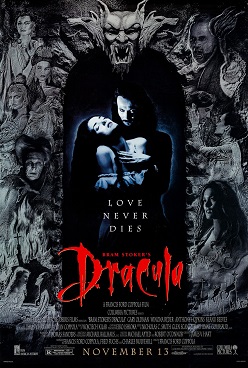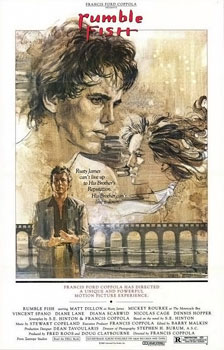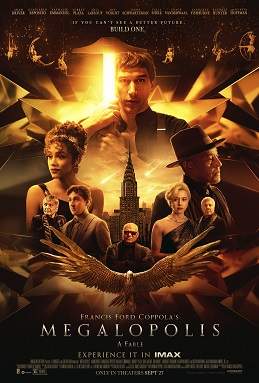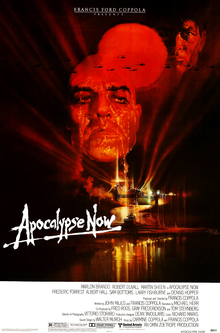
FRANCIS FORD COPPOLA
ICONIC MOVIES
FRANCIS FORD COPPOLA TEMPS AUDIENCES AS A GREAT CINEMATIC AUTEUR WITH ONE MASTERPIECE AFTER ANOTHER
By PETER THOMAS BUSCH
T
he Hollywood Studio system had more troubles than just financial. Filmmakers and actors began to resent the control the studio contracts had over careers, not just financially but artistically as well. Actors of the classic film era worked for one of only a handful of major studios under contract to do a certain number of films over a number of years. Studios often loaned out actors under contract to one of the other major studios with the actor having no say in the matter.
Charlie Chaplin formed United Artists with D. W. Griffith, Mary Pickford and Douglas Fairbanks, with the idea of starring in, producing and distributing their own films in 1919. United Artists also became a distribution company for other independent producers.
The studio system still dominated the Hollywood film industry for another fifty years even after a government anti-trust action broke up the near monopoly in which studios owned the distribution companies as well as the movie theatres.
Film actors and directors continued to be artists for hire with limited artistic freedom until a young group of filmmakers with university training in theatre and film production founded independent production companies.
Francis Ford Coppola gained experience in the film industry by working hands-on in a number of film projects during the 1960s. Coppola had studied theatre and eventually obtained a Master of Fine Arts Degree from the UCLA School of Theatre, Film and Television, just as the studio system was falling out of favour.
The new era of film making was accelerated by the end of the Production Code that had been enforced as a set of stringent moral guidelines for filmmaking. The new intellectual freedom in filmmaking and the actors and filmmakers becoming schooled in the art of making films resulted in a new wave of highly educated filmmakers adopting a more intellectual approach to developing scripts and telling narratives through images on film.
The new era filmmakers also looked to a different business model in which to develop film projects, although often without success. Coppola founded American Zoetrope and welcomed other filmmakers who wanted to develop projects outside the studio system, but he frequently found himself out of cash and redirected to the major studios as a filmmaker for hire, developing film projects and pitching them to Hollywood for financial backing and distribution support.
Coppola was still a director for hire, but he was able to also maintain the independent production facility in San Francisco.
The Academy of Motion Pictures, Arts and Sciences recognized this sweeping talent as an icon of the new era in film with four Oscars in just five years: one for Patton (1970), a script Coppola had developed for another filmmaker before beginning his own film projects.
Coppola was able to cast leading actors in his films, which lent to the film’s success as well as the successful career of the actors, beginning with Marlon Brando reinventing his career as Don Corleone in the Godfather (1972) and then again in Apocalypse Now (1979).
Brando’s career had stifled partly because he was notoriously difficult to work with, often unable to remember lines and painfully working out the details of his character only once on set through discussion with the director.
Brando also had difficulty pleasing the critics after a tremendous start to his career in the 1950s. And then after a while, Brando pretended not to care what the producers or critics thought, even refusing to accept the Oscar for his Godfather performance.
Coppola was able to work with Brando, with the actor and the filmmaker benefitted from the collaboration.
American Zoetrope was supported by a number of filmmakers and actors, included George Lucas. And although the film studio often suffered financially, Zoetrope ushered in a new era of filmmaking that persists to this day in which the filmmaker, not the studio, is the creative catalyst behind the film project.
Al Pacino would become a major movie star after roles in The Godfather and Godfather II as Michael Corleone, the son of the Italian Mafia boss operating in New York, played by Brando.
FRANCIS FORD COPPOLA UNABASHEDLY EXHIBITS A MASTERY OF CINEMATIC INFLUENCES WITHOUT CREATING CLICHE AND PASTICHE ON FILM
Coppola continued on when Pacino went to work for other directors, including the 1973 biopic about undercover New York police officer Serpico. Serpico uncovered widespread corruption within the New York Police Department.
Then came Rumble Fish (1983) which was produced in black and white for such rising stars of the day as Mickey Rourke, Matt Dillon and Diane Lane. Lane was just 19 years old, but she would go on to star in major motion pictures for three more decades as a character actor opposite such leading actors as Robert Downey Jr. in Chaplin (1992), George Clooney in The Perfect Storm (2000) and Richard Gere in Unfaithful (2002).
Coppola then made another biopic, starring Jeff Bridges as the biopic character Preston Tucker. Tucker was an automobile designer who tried to break into the Big 3 United States automobile manufacturing monopoly, but without success after being thwarted by the close relationship between politicians and big business in Tucker: The Man and His Dream (1988).
When actor Gary Oldman came along in the Nineties, Coppola cast him in one of the more seminal Dracula pictures ever made, Bram Stoker’s Dracula (1992).
Coppola changes genres to create a seminal piece on vampire lore while supporting the talents of another great young feature film actor. The Dracula film kind ’a swallows viewers whole, if the previous Coppola films had not already got them.
Oldman won an Oscar for Best Actor in a Leading Role for his portrayal of Winston Churchill in the biopic Darkest Hour (2017). Oldman was finally recognized with a golden statute after masterfully playing a number of biopic characters, including punk musician Sid Vicious in Sid and Nancy (1986), presidential assassin Lee Harvey Oswald in JFK (1992) and Ludwig van Beethoven in Immortal Beloved (1994).
Coppola was also involved in script development for the films he directed, allowing the actors he cast in leading roles to have some input into their own lines, thereby allowing them to excel for a single project as well as to go on to have stellar careers.
Coppola also made great art on film, beginning with the opening scene in Patton and carrying on with Brando’s Godfather, and then the subtle blend of two narratives, one historical and one contemporary about the rise of organized crime in Godfather II.
With early successes, Coppola went on to create masterpieces such as Apocalypse Now, Rumble Fish and Bram Stoker’s Dracula.
Coppola produced thematically complex films with anti-establishment themes that critiqued historical and contemporary topics, rather than merely present an entertaining storyline.
The film auteur was able to reinforce socially charged themes with stunning visual filmmaking and thoroughly inspiring dialogue.
Apocalypse Now is still considered the seminal feature film about the Vietnam War. Coppola’s montage of intellectually challenging subjects, and near enough documentary events, with artful film development and direction, put Coppola at the forefront of the new cinema.
Apocalypse Now follows the film’s protagonist, a secret military assassin, played by Martin Sheen, along his journey through the jungles of Vietnam to kill a rogue United States army Colonel. Marlon Brando plays Col. Walter E. Kurtz.
The audience knows the mission when perhaps many of the characters in the film do not, but the film builds suspense through various sub-narratives that explore the madness of war and the wrongness of the United States involvement in the Vietnam war in particular, until the ultimate plot reversal that twists and turns like the river journey on which the audience had just been taken. Coppola uses the river as a literary device.
Coppola was a storyteller. And, Coppola studied the theory of montage developed by Sergei Eisenstein as a way of exploring narrative development.
The opening scene, with Sheen stuck in a hotel room waiting for his next military assignment, and several transition scenes throughout the movie show how Coppola had mastered the montage technique with scenes bleeding through dark silhouettes as the narrative moves to the next stage along the river journey northward.
Coppola also shows influences of Akira Kurosawa, with close ups of Sheen, so close you can see the beads of sweat at the end of his strands of hair. Coppola also shot through foregrounds to film action scenes occurring in the background, like Sheen talking to Dennis Hopper’s character through the bamboo jail and the children peering in before setting him free again.
This type of film direction creates a lot of tension and suspense, and also displays the artistry of a filmmaker that compels audiences to watch their movies for fifty years.
Apocalypse Now and Rumble Fish are scripted with chiaroscuro light on colour film, like Rembrandt portraits, except the dialogue from dark themes embedded in the scripts shifts through the extensive gradation of light and darkness as the scenes develop.
Simultaneously, the popular rock and roll music of the Vietnam era, created by The Doors (also a product of the UCLA film school) and the Rolling Stones, syncs with the physical acting performances.

Apocalypse Now is so subtly complex and masterful as to become a transcendent work of art – making people think beyond the reality assembled by their current beliefs as opposed to a filmmaker simply entertaining people to sell theatre tickets.
Kurosawa’s dark humour is also influential in the beach scenes when Robert Duvall’s character is trying to get the soldiers under his command to surf during a firefight. Sheen steals a surfboard. And Duvall sends helicopter gun ships up the river looking for them to have the surfboard returned. (Apocalypse Now, Scene 12)
This blend of dark humour and imminent tragedy was developed by Kurosawa in a series of Japanese samurai warrior films.
Coppola then films Rumble Fish in black and white with flat audio techniques as a personification of the main character, played by Mickey Rourke, who is colour blind and tone deaf.
Coppola, like many filmmakers, would often use the same actors in subsequent films, such as Robert Duvall, Dennis Hopper, Laurence Fishburne, Diane Lane and Mickey Rourke. Fishburne was cast in minor speaking roles in Apocalypse Now and Rumble Fish, but he too went on to major feature film success with important roles in the Matrix Trilogy and Mission Impossible III.
Rourke would also be cast by Coppola in the biopic about down and out street poet Charles Bukowski in Barfly (1987). Faye Dunaway plays the love interest.
Duvall had roles in The Rain People (1969), Godfather and Apocalypse Now. The well regarded character actor continued through various phases of his life for 147 acting credits so far, becoming part of the popular film culture with such iconic lines as stated by his character, Cavalry Officer Lt. Col. Bill Kilgore, “Napalm .. nothing else in the world smells like that…that gasoline smell…the whole hill…smells like… victory…someday this war is going to end.” (Apocalypse Now, Scene 11)
Duvall takes on a Stanley Kubrick type character influenced by the film, Dr. Strangelove, a film about the real desire of American generals for a nuclear confrontation with Russia.
Coppola unabashedly shows a mastery of these cinematic influences without creating cliché and pastiche on film.
Coppola instead creates one of the most iconic self-reflective scenes in cinema by cameoing as a television war correspondent filming the soldiers landing on the beach.
“Don’t look at the camera – just keep going as though you are fighting – it’s for television.” (Apocalypse Now, Scene 4)
Coppola filmed in the Philippines, using the Philippine military’s American made helicopters. Production suffered damage from hurricanes and health issues among the cast, which caused cost overruns, while the whole world waited for another masterpiece from the filmmaker that brought global audiences the Godfather.
Coppola added extra layers of text onto subtexts with the use of literary devices that evoked deeper meaning in film than just mere entertainment, thereby allowing him to rely on master filmmaking techniques while producing original cinema art.
Art house films became mainstream, and Coppola was responsible for this filmmaker focused cinema becoming entrenched with theatre audiences.
Coppola was innovative and creative, not formulaic.
The Oscar winner did not repeatedly make more Godfather type films or another Patton. Coppola took new subject matter and created different films that reflected the reality of the subject so that audiences could gain a deeper, more thought provoking understanding of the art they were watching.
The scripts explain the impetus of formal authority contrasted against the personal realities of characters in such a way that casts long dark shadows of doubt onto the official versions of truth, while the visual imagery makes you never forget the intellectual discussion.

Francis Ford Coppola: A Filmmaker’s Life, by Michael Schumacher, New York, Crown Publishers, 1999.


